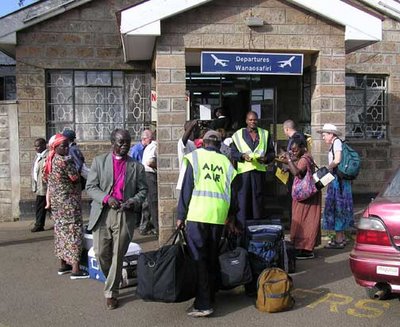 This was our arrival at Nairobi's Wilson Airport. It's a small airport, apparently catering to charter aircraft -- especially those chartered by NGOs and various humanitarian missions.
This was our arrival at Nairobi's Wilson Airport. It's a small airport, apparently catering to charter aircraft -- especially those chartered by NGOs and various humanitarian missions.
Father Bob has already written some about this flight. We took off from the small Nairobi airport that caters to charter flights – not from the big Nairobi international airport where we landed the night before. And he has explained about AIMAir, which operates those flights.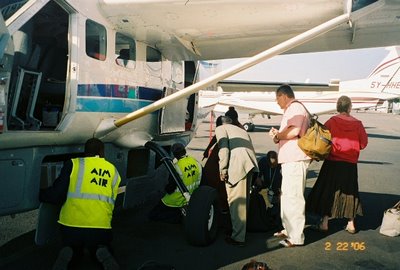
As I understand it, our diocese had chartered this flight. It was a very small jet. All of us had carried lots of baggage filled with gifts we wanted to take to Lui. Apparently, we were also going to transport goods from the Lui diocesan office (in Nairobi) into Lui. When all was calculated, we were several hundreds of pounds over the weight we had contracted for. The photo at left shows AIMAir staff, Rebecca, Archdeacon Robert, and Sandy, as we were trying to load our baggage. The Diocese of Missouri had already contracted with this charter-plane company for a certain amount of money. But it turned out we were transporting way more weight than had been agreed upon. Here, our pilot Dan is literally scratching his head trying to figure out he could get all of us people, our luggage, and the other goods all the way to the Mundri airstrip.
The Diocese of Missouri had already contracted with this charter-plane company for a certain amount of money. But it turned out we were transporting way more weight than had been agreed upon. Here, our pilot Dan is literally scratching his head trying to figure out he could get all of us people, our luggage, and the other goods all the way to the Mundri airstrip.
At first, it appeared we were going to have to leave many items in Nairobi, in order to get within the weight that had been agreed upon. But then there were some negotiations between Archdeacon Robert and our pilot. When all was said and done, we agreed to pay about $700 more money so that we could transport all our goods into Sudan. (The additional cost would cover the additional fuel that AIMAIR would use.) Otherwise, some of them would have had to wait for the next plane that the Diocese of Lui could have chartered.
At that time, I didn’t really understand why this was important. But here’s what was operating. Sudan has been so devastated by the civil wars of the past century that there is no remaining infrastructure there. There is no postal service. FedEx and UPS don’t even have a map of this area – much less make deliveries there. The only way that we can get materials into Lui is to send them to the diocesan office in Nairobi, then they ship those items on the next privately chartered plane into Lui. It means that all transport of goods is very slow and very expensive. As we took off from Nairobi, this sight caught us up short. This vast area, miles wide, is an immense ghetto where thousands upon thousands of Kenyans live in the most destitute poverty. If I understood correctly, in this “enclave,” they have about one latrine per 10,000 people. It boggles the mind.
As we took off from Nairobi, this sight caught us up short. This vast area, miles wide, is an immense ghetto where thousands upon thousands of Kenyans live in the most destitute poverty. If I understood correctly, in this “enclave,” they have about one latrine per 10,000 people. It boggles the mind.

We flew over some amazing terrain. This immense crater caught everybody’s attention. I'm not sure whether it's a volcanic or meteoric crater, but it sure is a sight to behold!
 We were also surprised to see dramatic mountains arising from the savannah.
We were also surprised to see dramatic mountains arising from the savannah.
We did not have a lot of information before making our trip, but we had been alerted that we – like our hosts – would be living in tukals (mud-walled huts with grass-thatched roofs). 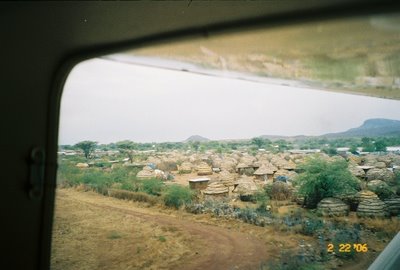 We all got excited at our first “tukal-sighting,” as we observed this village upon flying into Loki.
We all got excited at our first “tukal-sighting,” as we observed this village upon flying into Loki.
We landed in Loki… (last stop in Kenya, just south of Sudan), apparently to take on fuel.  This little village is amazing. Something of an urban center has sprung up here, as various NGOs [non-government organizations like the U.N., Red Cross, Doctors without Borders, etc.] have begun using it as a staging ground from which to launch humanitarian flights (food, water, medical supplies) into the devastated southern Sudan. The number of planes on the ground is greater than my one photo can capture …
This little village is amazing. Something of an urban center has sprung up here, as various NGOs [non-government organizations like the U.N., Red Cross, Doctors without Borders, etc.] have begun using it as a staging ground from which to launch humanitarian flights (food, water, medical supplies) into the devastated southern Sudan. The number of planes on the ground is greater than my one photo can capture … I’m not sure how clearly you can make out this image. But what's stretching between the two airplanes’ tails are row upon row of bags of food [grain?] ready for shipment into the people starving in Sudan, and the tents the UN maintains to manage this operation.
I’m not sure how clearly you can make out this image. But what's stretching between the two airplanes’ tails are row upon row of bags of food [grain?] ready for shipment into the people starving in Sudan, and the tents the UN maintains to manage this operation.
When the United Nations security guard on the ground saw that I was taking photographs, he came after me and made it quickly and forcefully clear that I was not to be taking photographs of this site. Why? I do not know. Some members of our group hypothesized that the U.N. is worried that journalists want to document evidence that the U.N. isn’t being as efficient as it should. Others hypothesized that the Sudanese government doesn’t want documentation of how dependent it is on foreign aid. What’s the truth? I haven’t a clue. It certainly was not my job or interest to document anything about any government or NGO. I was simply awed at the vast amount of energy being devoted to human relief from this staging-ground – as it suggests the vast numbers of people in the environs who need basic, subsistence nutrition.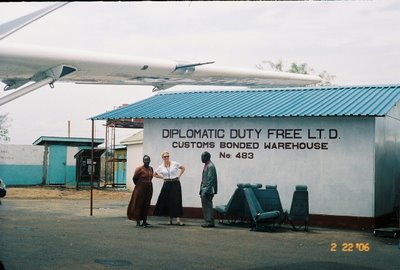 But … regardless of all that political intrigue … our group was happy to have a chance to stretch their legs, use the last flushing toilets we would see in a long time, and visit together. (Pictured here at Loki are Rebecca, Sandy, and Bishop Bullen.)
But … regardless of all that political intrigue … our group was happy to have a chance to stretch their legs, use the last flushing toilets we would see in a long time, and visit together. (Pictured here at Loki are Rebecca, Sandy, and Bishop Bullen.)
The plane trip from Nairobi to Lui (with stop-off in Loki) was about 7 hours. Future missioners should be forewarned to take food and water on that trip; we were not. So by the time we arrived in Lui, we were very hungry and thirsty.
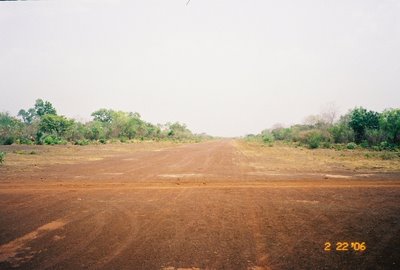 We landed at what we jokingly refer to as the “Mundri International Airport” that afternoon. It is merely a clearing or wide spot in the desert savannah.
We landed at what we jokingly refer to as the “Mundri International Airport” that afternoon. It is merely a clearing or wide spot in the desert savannah.
This was the first instance of a ritual that I saw repeated over and over. We were welcomed into every village as their “honored guests.’ We first saw that at our arrival in Mundri. The Bishop (who had traveled into Lui with us) was present, and so were all the senior clergy of the diocese.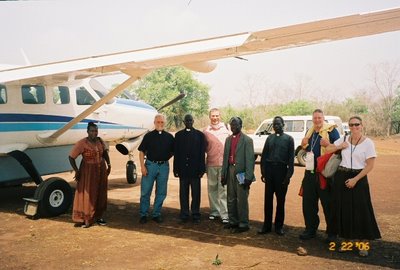
In this photo you see [left to right]
- Rebecca – a Moru from the Lui Diocese, who now works in the Diocese’s Nairobi office. Because of the civil war, she had not seen Lui in several years. But when we ended up with a spare seat on our plane, the Bishop offered her the chance to go home again for the first time in so very, very long.
- Father Bob Towner, one of our missioners
- Father Joseph Phillip, Dean of the Cathedral in Lui
- Archdeacon Robert Franken of our diocese
- Bishop Bullen of the Diocese of Lui
- Father Vasco, of the Diocese of Lui
- Rick Kuhn, one of the missioners
- Sandy Coburn, one of the missioners and co-chair of our Companion Diocese Relationship Committee
In my view, there is one funny thing about this photograph. I did not “stage” these people to position themselves in the shade cast by the airplane’s wing. That happened naturally! We had left the Missouri winter to land in Sudan’s 100 degree temperature. Our Lui hosts just instinctively sought out the shade, and we followed their lead. I thought it was pretty funny.




No comments:
Post a Comment